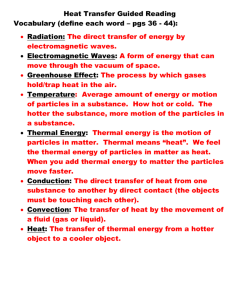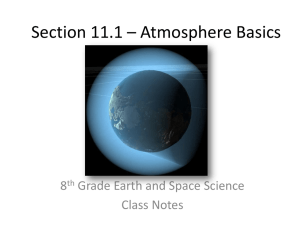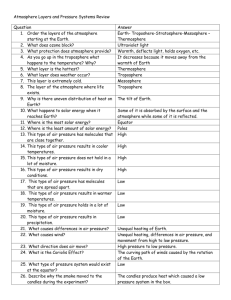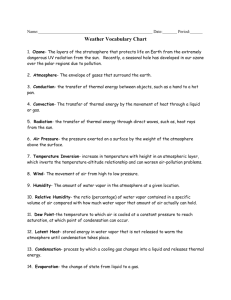File
advertisement
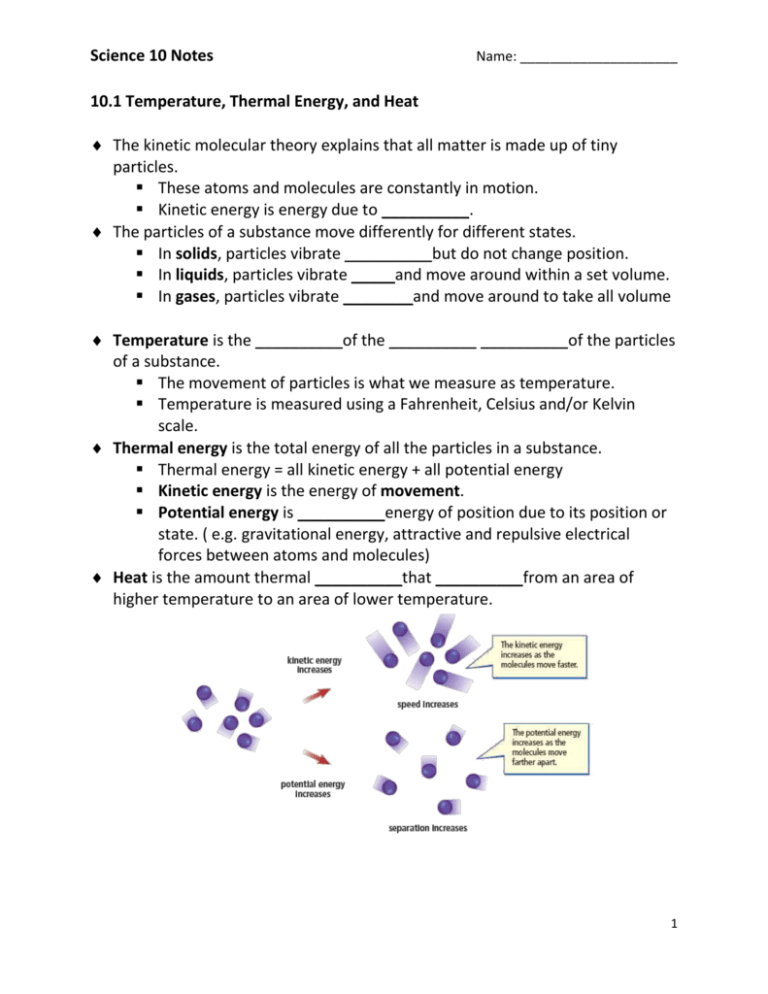
Science 10 Notes Name: _____________________ 10.1 Temperature, Thermal Energy, and Heat The kinetic molecular theory explains that all matter is made up of tiny particles. These atoms and molecules are constantly in motion. Kinetic energy is energy due to __________. The particles of a substance move differently for different states. In solids, particles vibrate __________but do not change position. In liquids, particles vibrate _____and move around within a set volume. In gases, particles vibrate ________and move around to take all volume Temperature is the __________of the __________ __________of the particles of a substance. The movement of particles is what we measure as temperature. Temperature is measured using a Fahrenheit, Celsius and/or Kelvin scale. Thermal energy is the total energy of all the particles in a substance. Thermal energy = all kinetic energy + all potential energy Kinetic energy is the energy of movement. Potential energy is __________energy of position due to its position or state. ( e.g. gravitational energy, attractive and repulsive electrical forces between atoms and molecules) Heat is the amount thermal __________that __________from an area of higher temperature to an area of lower temperature. 1 Science 10 Notes Name: _____________________ Thermal Energy Transfer Conduction is the transfer of heat by direct __________. Heat is transferred from higher temperature, higher kinetic energy, of particles to lower temperature, where particles have lower kinetic energy. For example, a cold spoon warms when placed in a cup of hot coffee. Thermal conductors transfer heat _________, while __________do not. Convection is the transfer of heat in fluids (__________and __________). Convection is the movement of heat from hot to cold within a fluid, or the movement of hot liquid to an area of cold liquid. Because there is a __________ __________, hot fluid (low density) moves to cold. This is how convection currents form. Radiation is the transfer of radiant energy by __________. What ___ _______ as heat is generally called __________radiation. Earth’s interior thermal energy comes from the core, plus some radioactive element decay. 10.2 Energy Transfer in the Atmosphere Earth’s atmosphere is a key factor in allowing ____ ___ _________ here. This narrow band of air has the right ingredients and maintains the ___________ _________, to allow life to form and survive. Originally, Earth’s atmosphere was very different and had no oxygen. Scientists think that oxygen first came from the breakdown of water by sunlight, then later from photosynthesis by plants. The density of the atmosphere __________with __________. 2 Science 10 Notes Name: _____________________ The Layers of the Atmosphere Earth’s atmosphere is made up of five layers. 1. The troposphere: __________to Earth’s surface, 8 km to 16 km thick __________ __________layer because all other layers compress it. ________ _____ ________ vapour in the atmosphere is found here. Therefore, this is where most _______ takes place. Solar energy and thermal energy from Earth keep air moving Temperatures range from average of +15ºC at the bottom to –55ºC at the top. 2. The stratosphere: the second layer, above the troposphere 10 km to 50 km above Earth, warming from –55ºC as altitude increases The air is _____, _____, and _____ in the stratosphere. Strong, steady winds, _____ often fly here to avoid turbulent troposphere. The _____ layer is found here, which _____ harmful UV radiation. The remaining three layers are known as the upper atmosphere. 3. The mesosphere: 50 km to 80 km above Earth Temperatures are as low as –100ºC This layer is where space debris burns up when it begins to hit particles. 4. The thermosphere: 80 km to 500 km above Earth Temperatures can reach +1500ºC to +3000ºC This is where the Northern Lights, aurora borealis, are found. Charged particles in Earth’s magnetic field collide with particles in the thermosphere. 5. The exosphere: 500 km to 700 km above Earth where the atmosphere merges with outer space. 3 Science 10 Notes Name: _____________________ Radiation and Conduction in the Atmosphere Almost all of the thermal energy on Earth comes from the Sun. Yet, this is only a small fraction of the solar radiation that reaches Earth. Most thermal energy is transferred near the equator, which receives a more direct source of solar radiation. Insolation = amount of solar radiation an _____ receives, measured in W/m2 Insolation _________ if there are particles of matter (dust, smoke) in the way or if the angle of incidence of the solar radiation is too great. Solar radiation does not heat the atmosphere _________. Earth’s ________ _______ solar radiation, heats up, then _________ the thermal energy into the atmosphere. This provides 70 percent of the air’s thermal energy. Convection currents in the air _________ the thermal energy around. The Radiation Budget and Albedo The radiation budget is used to explain where all of the solar radiation that reaches Earth actually goes. If all 342 W/m2 of solar radiation that reaches Earth was stored in the atmosphere, it would be far ____ ____ to support life as we know it. Earth’s radiation budget = heat gained – heat lost Of the of the solar radiation that reaches Earth, 15 percent is _________ by clouds back into space, 7 percent is _________ by particles back into space, 20 percent is _________ by clouds and the atmosphere, and 58 percent reaches Earth’s surface • 9 percent of this amount is _________ back out into space by Earth’s surface • 23 percent drives the _____ cycle, 7 percent creates _____, and 19 percent is re-radiated from Earth’s surface. 4 Science 10 Notes Name: _____________________ • Albedo refers to the amount of energy _________ by a _________. Light-coloured surfaces (snow, sand) have a _____ albedo and reflect energy. Dark-coloured surfaces (soil, water) have a _____ albedo and absorb energy. What Is Weather? Weather is the conditions in the atmosphere at a particular place and time. “Weather” describes all aspects of the atmosphere and is closely related to the transfer of thermal energy. Atmospheric pressure, measured with a barometer, is the amount of pressure the molecules in the atmosphere exert at a particular location and time. Atmospheric pressure is measured in kilopascals (kPa) = 1 N/m2 Our bodies equalize pressure = why our ears pop with pressure change At sea level, atmospheric pressure = 1 kg/cm2, and as you increase altitude, the pressure drops. 5 Science 10 Notes Name: _____________________ Warm air is lighter and less dense than cool air and so warm air has a lower pressure than cool air. Humid air (air with more water vapour) has lower pressure than dry air. When pressure drops moist air is arriving in the area. Specific humidity = the total amount of _____ _______ in the air. Dew point = the ___________ where no more water vapour can be held by air Relative humidity = the _________ of the air that is currently holding water vapour 45 percent relative humidity means that the air is holding 45 percent of the water vapour it could before reaching its dew point. Convection in the Atmosphere Wind is the movement of air from higher pressure to lower pressure. An air mass is a large body of air with similar temperature and humidity throughout. Air masses take on the conditions of the weather below. Air masses can be as large as an entire province or even larger. High pressure systems form when an air mass _____. This usually occurs over _____ water or land. Winds blow clockwise around the centre of the system. Low pressure systems form when an air mass _____. This usually occurs over _____ water or land. Winds blow counterclockwise around the centre of the system. Lows usually bring wet weather. 6 Science 10 Notes Name: _____________________ Prevailing Winds Prevailing winds are winds that are _________ for a _________. Winds in British Columbia usually blow in _____ the _________. Precipitation falls as air is forced up the mountain slopes. Air gets drier as it moves inland, continuing to drop precipitation. Dry air rushes down the far side of the mountains into the prairies. Jet Streams, Local Winds, and Fronts Strong winds occur in areas between high and low pressure systems. The boundaries between the global wind systems have very strong winds. In the upper troposphere, between warm and cool air, are the jet streams. The polar jet stream can move at 185 km/h for thousands of kilometres. Planes flying east across Canada “_____” the jet stream and _____ it flying west. Local winds arise and are influenced by local geography. In British Columbia, sea breezes blow inland (onshore breeze) when the land warms in the morning and outward (offshore breeze) when the land cools in the evening. A front is a _________ between two different air masses. Cold air forces warm air to rise, so fronts usually bring ______________. 7 Science 10 Notes Name: _____________________ Extreme Weather Air masses often have very large amounts of _________ energy. Extreme weather can arise under certain conditions as this energy is released. Thunderstorms occur when warm air rises and water condenses (which _________ even more _______), building the thunderhead even higher. _______ _______ can be built up and released as lightning. Sea breezes in the tropics and energetic cold (and even warm) fronts can cause thunderstorms. Tornadoes form when thunderstorms meet fast ____________ winds. A “funnel” of rotating air may form, which sometimes extends all the way to the ground with winds of up to 400 km/h. The tropics, with their intense heat, can often have severe weather. Large masses of warm, moist air rise quickly and cool air rushes in. Air rotates counterclockwise in the northern hemisphere, clockwise in the south. Hurricanes = tropical cyclones = typhoons 8


